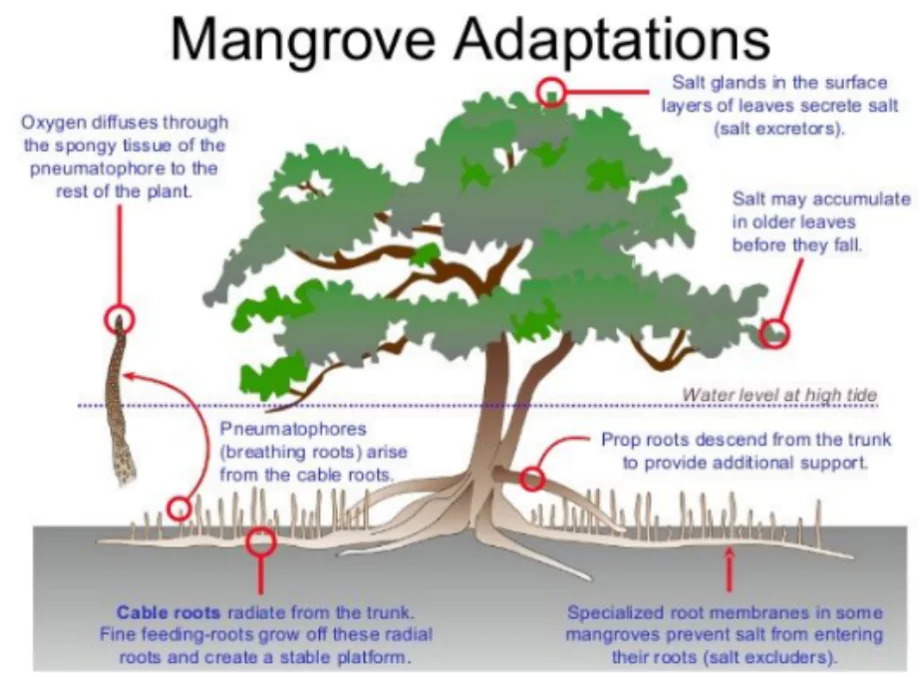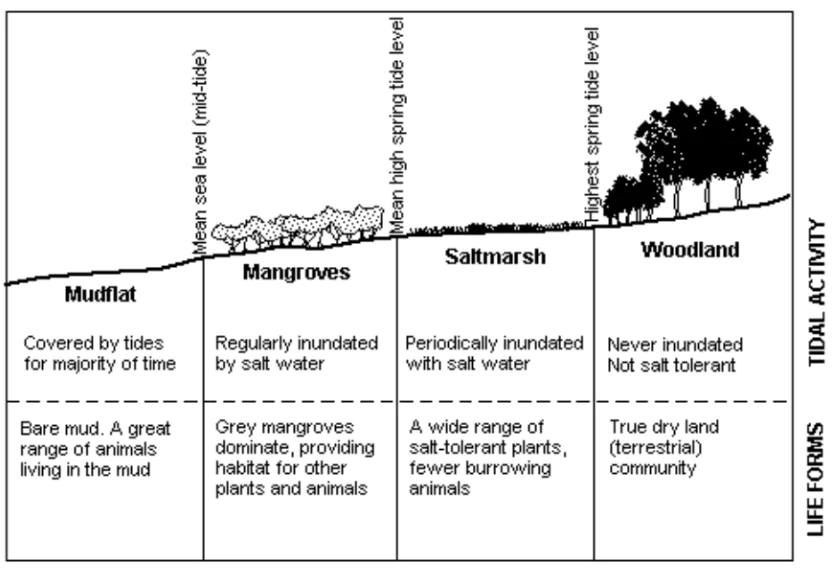26 July, is marked as the International Day for Conservation of Mangrove Ecosystems as declared by the United Nations Educational, Scientific, and Cultural Organization (UNESCO) in 2015.
- The day is marked to raise awareness towards mangrove ecosystems as “a unique, special and vulnerable ecosystem” and to promote solutions for their sustainable management, conservation and uses.
About Mangroves
- Location: Mangroves are found in tropical and subtropical areas, i.e., between 25°N and 25°S latitude.
- Significance: Mangroves are often called ‘sentinels of the coast’ given their ability to protect shorelines, absorb impacts of storms and cyclones, support fish nurseries, lock up carbon and nutrients, provide a gene pool, and offer a host of other benefits.
 Adaptation: Mangroves have specialized adaptation to survive in the extreme conditions of the coastal environment.
Adaptation: Mangroves have specialized adaptation to survive in the extreme conditions of the coastal environment. - They have the ability to survive in waterlogged and anoxic soil, and to tolerate brackish water with the adaptations.
- Stilt Roots
- Pneumatophores
- Salt Excretory Glands
- Salt Excluding Roots
- Viviparous seeds
- There are 24-29 families and around 70 species in the world.
- Global Rankings: Indonesia has the largest area of mangrove forest – totalling 20% of the global total – followed by Brazil, Australia, Mexico and Nigeria, which together contain almost half of the world’s mangroves.
Enroll now for UPSC Online Course
Mangrove Conservation In India
- Increase in Numbers: The extent of mangroves in the country has increased from 4,046 square kilometre (sq km) in 1987 to 4,992 sq km in 2019, according to biennial assessments published by the Forest Survey of India.
- India is one of the few countries with positive trends in mangrove cover.
- Total Mangrove Sites in India: As of 2021, the Ministry of Environment, Forests, and Climate Change (MoEF&CC) has documented 38 mangrove sites across India, according to the Annual Report MoEF&CC 2020-21.
- Maharashtra: It boasts the highest count of mangrove sites within a state, with 10 sites, closely followed by Orissa with 7 sites.
- States like Maharashtra have established a separate Mangrove Cell to ensure a consistent focus on the conservation and management of these ecosystems.
- Global Number Decreasing: The Global Mangrove Alliance, which maintains consistent global datasets on mangrove cover, has estimated that worldwide, since 1996, there has been a net global loss of mangrove cover by 3.4 per cent, with the losses having occurred globally at rates twice the gains.
Significance
- Disaster Mitigation: Mangrove coverage acts as a natural barrier, reducing the impact of waves and protecting coastal areas from erosion.
- It stabilizes sedimentation and mitigates coastal flooding, thus providing a valuable defence against natural disasters.
- A recent study estimated that India’s mangrove systems provide annual flood protection benefits of over $7.8 billion.
- Ex: During Supercyclone Amphan in 2020, Sundarbans mangroves played a big role in protecting the life and livelihood of millions of people by acting as a bio-shield and protecting the embankments.
- Mangroves are an essential part of the “build back better” strategy in response to sea storms, tsunamis, and cyclones.
- Ecosystem Services: Mangrove provide critical habitats of a diverse range of plant and animal species, and marine organisms, including commercially important fish species.
- Sundarbans host the world’s largest mangrove forest and are home to endangered species like the Bengal tiger and Ganges river dolphin.
- Natural Filter: Mangrove forests improve water quality and act as natural filters by trapping sediments, pollutants and excess nutrients.
- They play a role in the well-being of coastal communities and health of marine ecosystems.
- Carbon Sequestration: Mangrove ecosystems can absorb large amounts of carbon dioxide (CO2) from the atmosphere and store it in their biomass and sediments in a process known as sequestration.
- Globally, they are estimated to sequester 22.86 metric gigatonnes of CO2, which is about half the annual CO2 emissions from fossil fuels, land-use and industry.
- This buried carbon is known as “blue carbon” because it is stored underwater in coastal ecosystems like mangrove forests, seagrass beds and salt marshes.
- Livelihood: Mangroves contribute significantly to the livelihoods of 900,000 fisher households in India.
- They support artisanal fisheries and provide food and income for the local population.
- Roughly about 60% of India’s coastal marine fish species are dependent on the mangrove ecosystem.
- Mangrove forests play a crucial role in nurturing estuaries and supporting nature-based economies.
- Tourism and recreation: Mangroves provide opportunities for eco-tourism, birding, kayaking, and other nature-based activities that can support local communities’ sustainable economic growth.
Challenges faced by Mangrove Ecosystem
- Stress on Mangrove: National Decadal Wetland Change Atlas, published by Space Application Center in February 2022, reports that between 2006 and 2018, the natural coastal wetlands declined from 3.69 million ha to 3.62 million ha.
- Conversion of Intertidal mudflats to Wetland: The intertidal mudflats have decreased by a whopping 116,897 ha, and salt marshes by 5,647 ha.
- Thus, mangrove plantation on mudflats is equivalent to converting one wetland type to another, and a gain in mangrove area is due to the loss of critical functions that the mudflats provide.
Check Out UPSC CSE Books From PW Store
Intertidal flats
- The intertidal flats: The area of the coast comprised of sand, rock or mud, and inundated by the tidal waters, are critical habitats for birds, especially migratory shorebirds and numerous other species.
- The flats also lock up immense amounts of carbon in the mud.
- Threats: They are a crucial ecosystem under tremendous pressure from coastal development, reduced sediment delivery from major rivers, sinking river deltas, increased coastal erosion and sea-level rise.
- Worldwide, it is estimated that one-sixth of intertidal flats were lost during 1984-2016.

|
- Altered Coastline
- Reduced freshwater flows: Often reduced freshwater flows to the coast cut off the supply of freshwater and sediments to the coastline, creating high salinity and low sediment conditions that mangroves cannot sustain.
- Climate Change: It is altering our coastline in fundamental ways — the sea levels are rising, sea-surface temperatures are increasing, and the frequency and severity of coastal storms are on the rise.
- Global Warming: A 2-degree warmer world may increase mangrove growth and productivity.
- Yet, these ecosystems stand to be adversely impacted by the increase in cyclonic activity, sea level rise and decline in summer precipitation.
- Lack of accommodation space: The ability of mangroves to sustain under a changing climate is also linked with the availability of accommodation space — the space available for mangroves and other coastal ecosystems for vertical and lateral adjustments as sea level changes and involving the accumulation of sediments.
- Example: The lack of accommodation space may be a critical barrier for several cities with intensive build-up along mangroves, such as Mangroves of the Thane Creek in Mumbai.
- Past Becoming a poor predictor of the future: Most of our management plans for coastal areas are akin to driving looking into the rearview mirror.
- Conditions of the ecosystem in the past — say in the sixties or seventies guide management goal and outcome setting. However, the past becomes a poor predictor of the future in a changing climate.
- Declining Diversity: According to the IUCN red list, 11 of the 70 mangrove species in the world (16 percent) are at an elevated threat of extinction.
- Among them, two species, namely Sonneratia griffithii (critically endangered) and Heritiera fomes (endangered), are found in India.
- Oil Pollution: Oil spill causes physical suffocation and toxicological impacts to mangroves.
- Spilled oil covers the aerial breathing mangrove roots inhabiting gaseous exchange and disrupting oxygen transport to underground roots leading to death of trees.
- Urbanization: Infrastructure and housing schemes for increasing the human population are destroying the mangroves, as mangroves are drained and land is cleared to make space for urban projects.
Way Forward
- Mangrove restoration, therefore, needs a wider set of approaches: It should include ensuring the sufficient freshwater and sediments flow to the coast, preventing pollution and regulating infrastructure development.
- Mangroves are not just groves of salt-tolerant trees but stand enmeshed with other coastal ecosystems such as mudflats, lagoons, estuaries, salt marshes and numerous others.
- Sustaining the entire coastal ecosystem’s diversity and resilience and the lives and livelihoods of coastal communities is a more meaningful outcome.
- Accommodation Buffer: An accommodation buffer may be needed to prevent the coastal squeeze for newly developing areas around coastal ecosystems.
- Forward looking Management: Management should rather be looking into future scenarios, informed by tremendous advances in climate modelling and integrate suitable mitigation and adaptation options while implementing management plans.
- Include necessary adaptation and mitigation options: Managing mangroves and coastal ecosystems must factor in climate risks and include necessary adaptation and mitigation options.
- The available climate models would need to be downscaled and interpreted at the scales wherein hydrological and ecological processes affecting mangroves and coastal ecosystems make sense.
- Toolkit of mangrove restoration should be widened: It should include not just silvicultural measures but also restoration of hydrological and sediment regimes and blended grey-green solutions.
- Ecological and hydrological needs of mangroves and coastal ecosystems must be factored in sector plans for water resources, disaster risk reduction, fisheries, tourism and others.
- Adopting an inclusive “all of society” approach: Multiple values of coastal ecosystems need to be assessed and form the basis of societal behaviour change at all levels towards building coastal resilience. Adopting an inclusive “all of society” approach should be the core of this approach.
Enroll now for UPSC Online Classes
Conclusion
India’s 2030 vision of becoming a five trillion economy rests on ten elements — one of which is the blue economy — the economy sustained by coasts and oceans. Ensuring that our sentinels of the coast are conserved and effectively managed is critical to this goal. And this would require that mangrove conservation efforts incorporate major policy and programming shifts.
![]() 30 Jul 2024
30 Jul 2024
 Adaptation: Mangroves have specialized adaptation to survive in the extreme conditions of the coastal environment.
Adaptation: Mangroves have specialized adaptation to survive in the extreme conditions of the coastal environment. 